Somenos Garry Oak Protected Area
Restoration for Species at Risk, Somenos Style
-from a PowerPoint presentation by Dave Polster
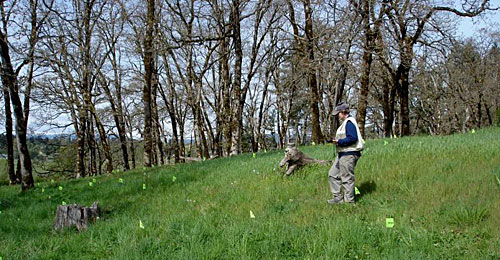
Biologist Tracy Fleming conducts a plant survey at Somenos Garry Oak Protected Area
Garry Oak ecosystem restoration is a relatively new field and we are gradually figuring out what works. This is a project I have been involved with for about 15 years – mostly trying to keep this rare deep soil Garry Oak site in Duncan, BC from becoming a housing development. After a lot of effort, eventually BC Parks forged a deal with the owner and the site became protected parkland. We didn’t want it to become an ecological reserve because we knew that we would need to do some experimenting to develop effective restoration strategies for this and other Garry Oak sites, so it remains ‘Somenos Garry Oak Protected Area’.
When we began to consider restoration, the first thing that was obvious was that the non-native shrubs Scotch broom and English hawthorn had invaded the site. Over the first few years literally tonnes of invading woody plants were removed.
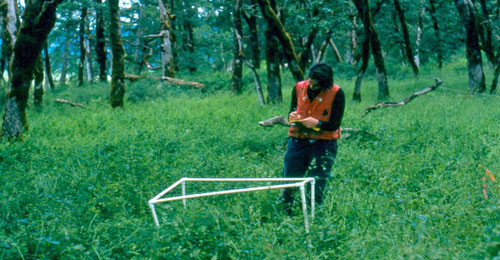
Biologist Carrina Maslovat conducts a survey
Experimental Plots
We then divided the area into four large experimental treatment blocks, one which served as a control, one where we would mow once per year only, one where we would mow and burn once, and the final block were we would mow and burn twice. Instead of creating square plots, we designed the plots to mimic the irregular shapes that might be created if the area were burned. First Nations burning has been recognized as a critical part of the natural disturbance regime that has sustained Garry Oak ecosystems historically, along with camas harvest. However, although we had everything lined up for burning in the summer of 2003, it was not to be. Because of the raging fires in Kelowna that summer, we were not able to gain permission to burn and we have still not burned the plots but have used mowing as a surrogate.
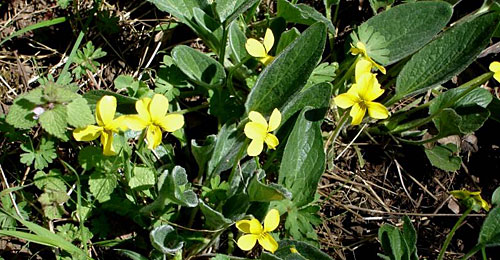
Endangered yellow montane violet
Monitoring Species at Risk
There have been up to eight species at risk at the Somenos site and the impacts of our restoration treatments on these species have been subject of much study. Somenos is the home of one of the largest populations of endangered yellow montane violet (Viola praemorsa) in Canada. Its population at Somenos has fluctuated over the years. The population of endangered Howell’s triteleia (Triteleia howellii) has increased, but blue-listed Howell’s violet (Viola howellii) seems to have declined. It may be due to the nature of this species. We don’t know. At this point we are continuing with the assumption that if we re-establish the ecosystem that operated here in pre-contact times we will probably benefit the rare species and other native species of the ecosystem. We have been monitoring the rare plant populations in detail as well as conducting detailed assessments of the vegetation over the years.
Re-establishment of large herbivores is another thought we have had for the Somenos site, but it is surrounded by urban areas and the Island Highway so this is not likely to happen. Blue-listed Roosevelt elk were seen at Somenos in September 2006.
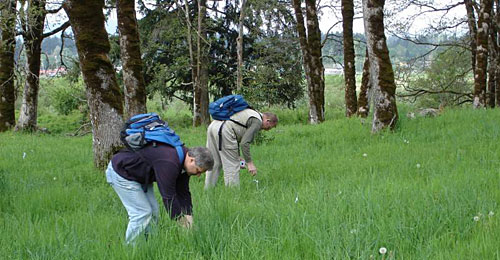
Biologists Matt Fairbarns and Hans Roemer survey rare plants
Complexity
The yellow montane violet population has varied so much, it is clear that we need to know more about the ecology of this species. For example, how does its relationship with ants influence its population? Ants are attracted to a sweet part of the seed. And the relationship of the violets to the rest of the ecosystem is equally dynamic. Of course, one of the issues of being out on the edge of restoration ecology is that the ideas we are working with have not been fully tested. We are learning as we go. We continue counting and measuring and planting of common native species. Over the years more than 60,000 native grasses and forbs have been planted in an effort to re-stitch the fabric of the ecosystem.

Planting native grasses to re-stitch the fabric of the ecosystem
Are we doing the right thing? It is clear that the more we know about these complex ecosystems the less we understand, but we are hopeful that we are making a difference, at least in terms of increasing awareness of these wonderful ecosystems with the knowledge we are gaining in the face of continued urban threats.
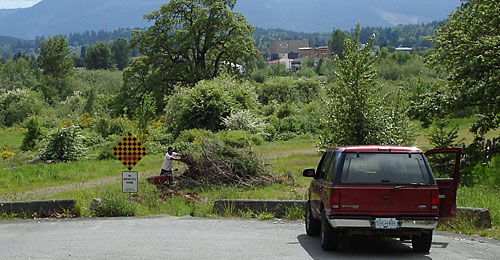
Results of the detailed vegetation studies of this site are available through GOERT.